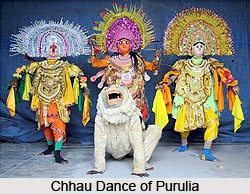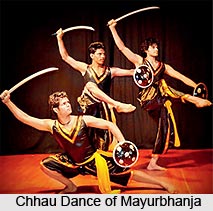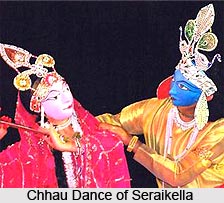 The Chhau dance is native to the eastern parts of India. It probably originated as a martial art, which is why it comprises vigorous movements and leaps. This variety of dance is prevalent in the princely states of Purulia, Mayurbhanja and Seraikella. This dance was once performed exclusively by men.
The Chhau dance is native to the eastern parts of India. It probably originated as a martial art, which is why it comprises vigorous movements and leaps. This variety of dance is prevalent in the princely states of Purulia, Mayurbhanja and Seraikella. This dance was once performed exclusively by men.
The steps and movements, the attack and defence, the performers, each holding a sword and shield, dividing themselves into two parties, the drums and their mode of play, the huge kettle drum known as "Dhumusa" a must in the orchestra, its reverberating powerful beats energizing the dancers, all signify that Chhau dance is unmistakably originated from martial practices.
Etymology
Etymologically, Chhau is derived from the Sanskrit word "Chhaya" which means a mask but some scholars are of opinion that Chhau is an independent colloquial Odissi word, meaning to attack or hunt stealthily.
Themes of Chhau Dance
In a Chhau performance, the depiction of birds and animals is a distinctive feature; there are also heroic dances with sword, bow or shield, by means of which the dancers demonstrate their dexterity. Themes in Chhau dance are mythical as it is mainly based on various episodes of the epics. Chhau draws its themes from epics like the Ramayana, the Mahabharata while incorporating folk and tribal elements. Two Rasas are dominant in the performance- Vira and Rudra, and in the end, forces of evil are punished and the righteous triumphs. Over a period of time, female characters and more diverse themes were added.
In Purulia it is the episode of the Ramayana which is presented through this dance-drama. In Seraikella and Mayurbhanja themes have been secularised. The performances are not held on the basis of any written diction in either of the places. It has been found that it is the Bengali translation of the Ramayana by Kavi Chandra that is generally adopted for performance. By the later half of 17th century, the episode of the Ramayana was first adopted in Chhau dance and subsequently the episodes from the Mahabharata and the Puranas entered into it.
 Themes of Purulia Chhau Dance
Themes of Purulia Chhau Dance
A common episode presented is Purulia which produces a fight between Lord Shiva and Lord Rama. This episode is also known as Shiva-Ramar Yudha or a fight between Shiva and Rama. The theme is not according to the classical Ramayana or any other subsequent Puranas. It is based on a popular tradition which developed in the western districts of West Bengal. Thereafter it was incorporated within the popular Ramayana of the area. The Puranic and pseudo-Puranic episodes which have been adopted for the Chhau dance of Purulia represent essentially the temperament of Bengal. Elements of tremendous kinetic fury and fast footwork with mellowed elegance and lyricism are combined. Episodes like the fight of "Abhimanyu" with the "Sapta Rathis", the killing of "Mahishasura", "Shiva Tandav", "Kirat Arjuna", "Jambeb", "Garuda Bahana", etc. are popular. The Krishna themes like "Bastraharan", "Kalanka Bhanjan", "Nisitha Milan", "Banshi Chori" and "Tamudia Krishna" are drew heavily on the local folk tradition. There are significant tribal themes like "Sabara Toka", "Kala Chakra" and "Sabara Sabaruni".
Themes of Mayurbhanja Chhau Dance
The Mayurbhanja repertoire treasures the highest number of dance items, rarely found in any other dance forms of the world. In course of time things of all varieties with special emphasis on the heroic ones were incorporated. The dance is more famous for its group numbers sometimes having more than twenty characters at a time. Most of the themes of Puranic episodes like Mayashavari, Kirata Arjuna, Saptarathi, Garuda Bahan, Dwaparleela, Vastra Haran, Bhasmasura etc are performed. The duet dances are but a few. Most famous of them are Geeta and Rangapanda. The characters of the dances are Krishna, Shiva, Rama, Parashuram, Hanuman, Shavara, Dandi, Jambaban, Indrajeet etc. The themes combining elements of tremendous kinetic fury and very fast foot work with mellowed elegance and lyricism become visual poetry of strong passions gestured in a style that is free, intense, affluent, dynamic yet melodious.
Themes of Seraikella Chhau Dance
The colourful repertory of the Chhau Dance of Seraikella consists of the following items: solo items, duet items, items with four artists, group items and the war dance. No songs are sung in Chhau of Seraikella but the music is based on traditional tunes of songs, the Chhandas and the Champus.
Moods and Modes:
 Keeping with the martial tradition. Chhau Dance in its rudimentary form had only one dominating mood "Tandava Bhaba" or heroism. The solo dancers simply display stylised vigorous movements with sword and shield in hands. When themes were introduced and group items were composed the dance has to widen its moods and modes, corresponding to the demand of the characters. More the need was due to the introducing of female characters. So, Chhau had to evolve three modes of rendering of movements to build up the general aesthetic climate. The first "Hatiardhara", meaning holding of an arm for martial and masculine characters, "Kalibhanga", meaning the pliant end of a spring for more delicate lyrical and non-martial characters especially females and "Kalikata", meaning to cut off the tender spring with a weapon is a judicious mixture of the other two for both male and female characters.
Keeping with the martial tradition. Chhau Dance in its rudimentary form had only one dominating mood "Tandava Bhaba" or heroism. The solo dancers simply display stylised vigorous movements with sword and shield in hands. When themes were introduced and group items were composed the dance has to widen its moods and modes, corresponding to the demand of the characters. More the need was due to the introducing of female characters. So, Chhau had to evolve three modes of rendering of movements to build up the general aesthetic climate. The first "Hatiardhara", meaning holding of an arm for martial and masculine characters, "Kalibhanga", meaning the pliant end of a spring for more delicate lyrical and non-martial characters especially females and "Kalikata", meaning to cut off the tender spring with a weapon is a judicious mixture of the other two for both male and female characters.
Today, the subject matter is borrowed from the gamut of animate and inanimate nature. The female peacock, swan and deer dances depict the wild beauty and grace of the form. The hilly region of north -eastern Orissa with a rich folk and tribal culture has influenced the dance.




